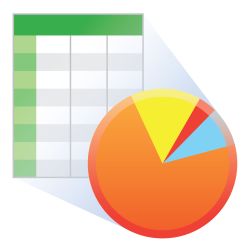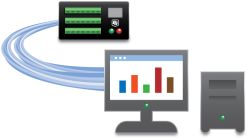This product is not available for new orders. We recommend ordering: CR350.

| Services Available |
|---|
Überblick
Der CR850 ist ein kleinerer Logger mit Forschungsstandard und eingebautem Keyboard Display. Er ist ideal für kleinere Systeme mit wenigen Sensoren und verfügt über 4MB internen Speicher für Daten und Programme. Es sind verschiedene Arten der Datenübertragung möglich wie Ethernet (nur über NL200), GSM, GPRS, Funk usw.
Lesen Sie mehrFunktionen und Vorteile
- Integrated keyboard and display screen let you program, manually initiate data transfers, and view data, all on site.
- Ideal applications include wind profiling, weather stations, ETo/agriculture, air quality, soil moisture, water level/stage, aquaculture, vehicle testing, Time Domain Reflectometry, SCADA, and water quality
- Simpler in design, the CR800 and CR850 are easier to program and wire.
- Serial communications with serial sensors and devices supported via I/O port pairs
- Contains custom ASIC chip that expands pulse count, control port, and serial communications capabilities
- Supports PakBus, Modbus, SDI-12, and DNP3 protocols
- Compatible with channel expansion peripherals allowing you to expand your system
- Includes both an CS I/O port and an RS-232 port for connecting communication devices
- Gas Discharge Tube (GDT) protected inputs
- Battery-backed clock that ensures accurate time is maintained while data logger is disconnected from battery power
- Program with LoggerNet, PC400, or Short Cut to fit your setup
Bilder










3D/CAD-Dateien:
Zugehörige Produkte
Technische Beschreibung
The CR850 consists of measurement electronics encased in a plastic shell with an integrated wiring panel, 16- character keyboard, and display screen. The display can show 8 lines x 21 characters (64 x 128 pixels). Custom menus are supported allowing customers to set up choices within the datalogger program that can be initiated by a simple “toggle” or “pick list”. Its keyboard and display screen is used to program the datalogger, manually initiate data transfer, and display data.
The CR850 uses an external power supply. Low power consumption allows the it to operate for extended periods on a battery recharged with a solar panel—eliminating the need for AC power. The CR850 suspends execution when primary power drops below 9.6 V, reducing the possibility of inaccurate measurements.
The on-board operating system includes measurement, processing, and output instructions for programming the datalogger. The programming language, CRBasic, uses a BASIC-like syntax. Measurement instructions specific to bridge configurations, voltage outputs, thermocouples, and pulse/frequency signals are included. Processing instructions support algebraic, statistical, and transcendental functions for on-site processing. Output instructions process data over time and control external devices.
Kompatibel mit
Please note: The following shows notable compatibility information. It is not a comprehensive list of all compatible products.
Software
| Product | Compatible | Note |
|---|---|---|
| LoggerNet | (Version 3.3 or higher) | |
| PC200 (retired) | ||
| PCONNECT (retired) | (Version 3.3 or higher) | |
| PCONNECTCE (retired) | (Version 2.2 or higher) | |
| RTDAQ | ||
| Short Cut |
Miscellaneous
| Product | Compatible | Note |
|---|---|---|
| PC400 | (Version 1.4 or higher) |
Additional Compatibility Information
Sensors
With several channel types, the CR850 is compatible with nearly every available sensor, including thermocouples, SDI-12 sensors, and 4 to 20 mA sensors. A custom ASIC chip expands its pulse count, control port, and serial communications capabilities. The CR850's I/O ports can be paired as transmit and receive, allowing serial communications with serial sensors and devices.
Measurement & Control Peripherals
The CR850 is compatible with all of our CDMs (requires an SC-CPI), SDMs, multiplexers, vibrating-wire interfaces, terminal input modules, and relays.
Communications
The CR850 communicates with a PC via direct connect, NL201 Ethernet Interface, multidrop modems, short haul modems, phone modems (land line, digital cellular, and voice-synthesized), RF telemetry, and satellite transmitters (Argos and High Data Rate GOES).
Data can be viewed on its onboard keyboard display, CD100 Mountable Display with Keypad, user-supplied iOS or Android device (requires LoggerLink), CD295 DataView II Display, or a user-supplied PDA (PConnect or PConnectCE software required).
The SC115 is the only compatible external data storage device. The CR850 does not have a peripheral port and is therefore not compatible with the CFM100, NL115, or NL120.
Enclosures
The CR850 and its power supply can be housed in any of our standard enclosures.
Power
Any 12 Vdc source can power the CR850 datalogger. Power supplies commonly used with the CR850 are the BPALK, PS100, and PS200. The BPALK provides eight non-rechargeable D-cell alkaline batteries with a 7.5 A h rating at 20°C.
Both the PS100 and PS200 consist of a sealed rechargeable 7 A h battery and a charging regulator. Their battery should be connected to a charging source (either a wall charger or solar panel). These two power supplies differ in their charging regulator. The PS100 has a standard regulator and the PS200 has a micro-controller-based smart regulator. The PS200's regulator provides two-step constant voltage charging and temperature compensation that optimize battery charging and increases the battery’s life.
Also available are the BP12 and BP24 battery packs, which provide nominal ratings of 12 and 24 A h, respectively. These batteries should be connected to a regulated charging source (e.g., a CH100 or CH200 connected to a unregulated solar panel or wall charger).
Software
CRBasic, the CR850's full programming language, supports simple or complex programming and many onboard data reduction processes.
Spezifikationen
| -NOTE- | Note: Additional specifications are listed in the CR800-Series Specifications Sheet. |
| Operating Temperature Range |
|
| Analog Inputs | 6 single-ended or 3 differential (individually configured) |
| Pulse Counters | 2 |
| Voltage Excitation Terminals | 2 (VX1, VX2) |
| Communications Ports |
|
| Switched 12 Volt | 1 terminal |
| Digital I/O |
|
| Input Limits | ±5 V |
| Analog Voltage Accuracy | ±(0.06% of reading + offset) at 0° to 40°C |
| ADC | 13-bit |
| Power Requirements | 9.6 to 16 Vdc |
| Real-Time Clock Accuracy | ±3 min. per year (Correction via GPS optional.) |
| Internet Protocols | FTP, HTTP, XML POP3, SMTP, Telnet, NTCIP, NTP |
| Communication Protocols | PakBus, Modbus, DNP3, SDI-12, SDM |
| Warranty | 3 years |
| Idle Current Drain, Average | 1 mA (@ 12 Vdc) |
| Active Current Drain, Average |
|
| Dimensions | 24.1 x 10.4 x 5.1 cm (9.5 x 4.1 x 2 in.) |
| Weight | 0.7 kg (1.5 lb) |
Dokumente
Broschüren Produkte
Technische Artikel
- Voltage Accuracy, Self-Calibration, and Ratiometric Measurements
- Preventing and Attacking Measurement Noise Problems
- Benefits of Input Reversal and Excitation Reversal for Voltage Measurements
- BACnet to Modbus Protocol Conversion (App. Note: 1M-C)
- FTP Streaming
- Serial Sensors: Interfacing with CSI Dataloggers (App. Note Code: 2MI-V)
- DNP3 with Campbell Scientific Dataloggers
Übereinstimmung mit Richtlinien u. Vorschriften
Videos & Tutorials
Downloads
CR800 OS v.32.07 (4.41 MB) 15-05-2024
Execution of this download installs the CR800 Operating System and Compiler on your computer. It also updates the CR800 support files for the CRBasic Editor.
Note: This OS has crossed the 2 Meg CR800 size limit for remote download. The OS must be downloaded to the 2 Meg CR800 via direct connect with the Device Configuration Utility. All OS download methods are supported by the 4 Meg CR800.
Upgrading from versions prior to version 28 of the Operating System will reset the datalogger’s CPU drive. This is due to a change in the format of the file system from FAT16 to FAT32. In order for the datalogger to operate correctly, as part of the upgrade, the CPU drive is formatted to FAT32. Any programs stored and running from the CPU drive will be lost. It is not recommended to update the datalogger’s Operating System over a remote connection where program control regulates the communication equipment (turning it on or off, etc.). In these cases, an on-site visit and a backup using DevConfig’s backup utility is necessary to update the datalogger’s Operating System.
Watch the Video Tutorial: Sending an OS to a Local Datalogger.
In all cases where the datalogger is being updated from an Operating System prior to 28, the use of DevConfig’s backup utility is recommended due to the CPU drive being formatted using the new FAT32 format.
Device Configuration Utility v.2.32.01 (47.7 MB) 15-04-2025
A software utility used to download operating systems and set up Campbell Scientific hardware. Also will update PakBus Graph and the Network Planner if they have been installed previously by another Campbell Scientific software package.
Supported Operating Systems:
Windows 11 or 10 (Both 32 and 64 bit)
FAQs für
Number of FAQs related to CR850: 147
Alle anzeigenWenige anzeigen
-
Yes, using the DisplayMenu/EndMenu() and MenuItem instructions.
-
Yes. Many customers use the Iridium satellite transceiver.
-
Multiple SDI-12 sensors can be connected to control ports C1 and C3 on the CR800. If multiple sensors are wired to a single channel, each sensor must have a unique address. SDI-12 standard version 1.3 sensors accept addresses 0 to 9, a to z, and A to Z.
-
Calibration is recommended every two years.
-
The upper limit is limited by a surge protection device on the wiring panel, which is a 1.5KE20CA. The key limit is for constant dc voltages; it starts to become leaky as the voltage increases and reaches the range of its nominal surge clamp voltage of 20 V. It is possible to damage that component if the voltage is continuously held near its clamp voltage, causing it to dissipate a lot of power.
There are also other issues of internal heat generation, which could increase measurement errors at high temperatures—especially if powering sensors or peripherals from the data logger.
This is why the limit of 16 V is quoted, which is within the normal operational voltage of lead-acid batteries. If the voltage creeps a little above this, especially when cold, it should not cause a problem.
-
Yes. The CR800 and CR850 are compatible with exactly the same options as the CR1000 but with a lower channel count.
-
Use the CURS100 device or a precision 100 ohm resistor to make 4 to 20 mA measurements.
Anwendungsbeispiele
The Charlotte-Mecklenburg Flood Information and Notification System (FINS) consists of over 125 gaging stations spread......lesen Sie mehr
Weather is, of course, a critical component of safe and efficient air travel. Pilots, navigators,......lesen Sie mehr
High-grade coal has been mined on the West Coast of New Zealand since the 1870s.......lesen Sie mehr











































